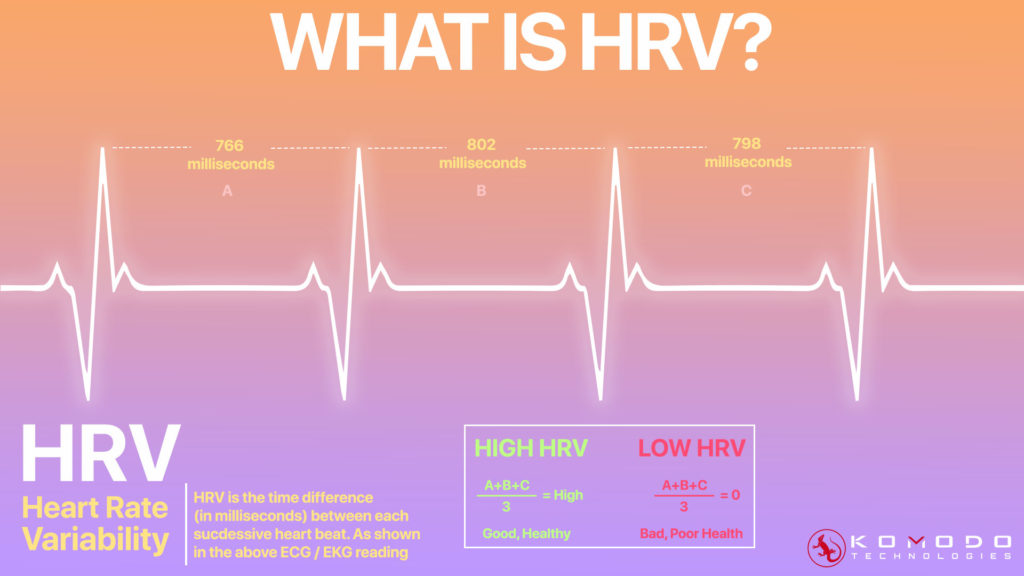Last Edit [ June 2024 ]
By Elvis Goren, KOMODO
In this Article…
- What is Heart Rate Variability
- How Does Heart Rate Variability Work
- The Technology Behind HRV
- What is a Good Heart Rate Variability
- How To Improve HRV
- HRV and Diet
- HRV and Exercise
- HRV and Sleep
- HRV and Stress
- Application of HRV
- Can HRV be Too High?
- Is HRV Reliable?
There is a lot of misconception about heart rate variability (HRV) online and in prominent medical papers. If you search “ What is HRV “ you will see two things. First you’ll see some vague articles from Harvard health, WebMD and Johns Hopkins. However, it is not in the interest of big pharma and big medicine to promote HRV because heart rate variability gives individuals true health independence.
The second thing you will see is articles and product placement from some of the top HRV device companies. Here you will see the fireworks, trying to lead you to purchase their products. But there must be an in between; The Truth.
What is Heart Rate Variability (HRV)
In technical terms, heart rate variability is the time difference, in milliseconds, between each successive heart beats. Our heart beats aren’t static. Think of the Queen song “We Will Rock You” which is the same beat on and on. Our heart rates are more like “Flight of the Bumblebee.” So from beat to beat to beat, HRV is measuring the change between 2 heart beats as compared to the prior two (see chart below)

How Does Heart Rate Variability Work?
So what does this all mean? Essentially, a high heart rate variability is a good thing. It means your overall health, heart, stress level is optimal. A low HRV means the opposite. Every HRV monitor has a different way of showing HRV. For example, The AIO Smart Sleeve has a 5-star system while WHOOP has a score out of 100. And then the more confusing devices like Apple show HRV in milliseconds.
HRV is like your body’s check engine light, an MRI into your internal health, a measure of your stress level, the overall health and wellbeing of your body. It’s truly an incredible tool if you know how it works, and have knowledge of the technology behind it.
Study #1: HRV and Problematic Internet Use
In today’s digital world, problematic Internet use is a growing concern. A study led by Wei-Lieh Huang investigated whether Heart Rate Variability (HRV) could be a marker for this issue. HRV is a measure of the variation in time between each heartbeat, and it can be influenced by stress and other factors.
The researchers found that people with problematic Internet use had different baseline HRV compared to those without. However, when exposed to different stimuli, their HRV didn’t change significantly. This study suggests that HRV could potentially be used to identify people at risk of problematic Internet use, but more research is needed.
The Technology Behind HRV
Here’s something you won’t read everywhere. Not all HRV is built the same. There are different ways to acquire HRV and one is more accurate than the rest
RMSSD VS SDNN
There are two types of algorithms devices use to display the end result, your HRV score. SDNN simply records your heart rate (BPM), takes an average throughout the day (usually a 24-hour period) and displays your HRV result in the form of milliseconds. This is done by Apple and Fitbit because it’s easy, but not as accurate as the next method. More on that here.
RMSSD actually records the time difference between beats in real time. A more complex (and accurate formula) that is used by companies like Whoop and Komodo’s AIO Smart Sleeve. More on that here.
ECG VS OPTICAL SENSOR (BPM)
No that we’ve talked about the algorithm, let’s talk about the input method. Where is the device acquiring the heart signal from. Almost all companies use the optical sensor because of its versatility and ability to show other information. However, it is much less accurate that an electrocardiogram.
The AIO Sleeve is the only company that extracts HRV value from an ECG / EKG. To get an idea of the difference: a standard optical sensor uses 50 samples per second, whereas ECG uses a minimum of 300 samples per second. This is how often the sensor feeds data to your smartphone. This is quite significant, and is the reason all professionals prefer to work with ECG.
What is a Good Heart Rate Variability?
The only person who knows the answer to this question is you. An 80-year-old with a heart condition and a 28-year-old athlete will have different ideas of what is a good heart rate variability. You will first need to establish your average heart rate variability, or baseline and go from there. Spending a few weeks monitoring your HRV throughout the day will give you a sense of where you’re at. Only then can you break down your daily routine and begin optimizing and increasing your HRV.
How to Improve Heart Rate Variability?
Study #2: A Breath of Fresh Air for Heart Health
Breathing might seem straightforward, but a study by Lluis Capdevila shows that there’s more to it when it comes to Heart Rate Variability Biofeedback (HRVB). This technique involves breathing at a certain rhythm to improve heart health and well-being.
Capdevila’s study reviewed 143 other studies and found three main methods of teaching HRVB. However, many of these studies didn’t provide enough detail about their methods. This lack of information makes it difficult to compare results and draw conclusions. The study calls for more standardized methods and better reporting in HRVB research, which could lead to more effective real-world applications.
Many factors will affect your HRV. It takes time to establish what your baseline is, understand your body and begin making the necessary changes. Here are the areas you will want to consider as they all have an affect on your health.
1. Heart Rate Variability and your diet

Every individual has a unique reaction to different foods even though they aren’t consciously aware. You should check you HRV before and after meals to see how that food affects your body. And it could be different day-to-day depending on how much stress you’ve put your body through that day. So if you eat the same foods every day, and you notice that on Wednesday your HRV dipped significantly after a meal, you should analyze what you did that day and why your body reacted differently. Perhaps you had a fight with a friend, got called in to HR at work or broke up with a significant other. Yes, these things can all contribute to high stress that will inevitably affect everything else you do that day
2. Heart Rate Variability and exercise
Lots of professional sports teams use HRV as a tool to optimize player performance and recovery. But you don’t need to be a pro to use it. You can use it if you’re doing cross fit, yoga, cycling, even walking your dog and doing lawn work. It’s truly a universal tool. When you exercise, your HRV will automatically decrease. This is because working puts your body under a great amount of stress. But that’s ok. This is good stress. However, if that stress from the workout follows you all day long, that’s not good.
HRV is used to gauge how well one recovers from stress, in this case, it’s exercise. If you are fully recovered and your HRV is back to it’s baseline within 1-2 hours, that’s good! It’s a sign of a healthy functioning body that recovers quickly from training. If your HRV stays the same and doesn’t change for hours upon hours, that’s not a good sign. Maybe you went to hard at the gym or on your bike ride. But with HRV, this could have easily been avoided.
Are You Ready?
Another way we use heart rate variability with activity is readiness. If you know you HRV baseline, or your average, and you notice it’s much lower before heading out on your run, you might want to think twice. Exercising and straining your body when HRV is below it’s average definitely does more harm than good. Could be a sign to take the day off or just do light activates. If HRV is well above your average, you’re good to go! But remember, constantly straining your body when you see a low HRV will not only negatively affect a single day, but could ruin an entire week if it becomes a pattern. Again, HRV gives you control over your own body, and destiny. Cool, right?
3. Heart Rate Variability and Sleep?
Study #3; COVID-19 and the Athlete’s Heart
In the world of sports, an athlete’s health and readiness to play are crucial. A recent study led by Sylvain Laborde explored how COVID-19 impacts the heart rate variability (HRV) of elite athletes. HRV is a measure of the variation in time between each heartbeat, and it’s often used as an indicator of an individual’s response to stress and exercise recovery.
The study involved 60 elite athletes, half of whom had contracted COVID-19. The researchers measured the athletes’ heart rate, blood pressure, and HRV both at rest and during a physical challenge. The results showed that athletes who had battled COVID-19 had higher heart rates, lower blood pressure, and lower HRV. This suggests that COVID-19 might impact the athletes’ cardiovascular function and their body’s ability to manage stress and recover from exercise.
Ok, so yes, many fitness trackers already come with sleep monitoring that you can view on an app. But it’s only tracking how you move at night to determine whether you are in deep sleep or not. While this is good, it doesn’t give us a complete picture. I mean what good is the Mona Lisa without her head, right?

Measuring HRV before bed and when you wake up gives us true indication of sleep quality and whether one is fully recovered from the day before. If some days are better than others, pay attention to what it is your doing on good sleep days vs. bad ones. Notice your nighttime routine. Are you on your phone a lot? Did you eat before bed? Did you consume alcohol? See what happens to HRV in the morning if you don’t do these things and optimize your sleep.
4. HRV and Stress
Study #4: The Heart’s Secret Code to Therapy Success
In the world of mental health, therapy is a common tool to help manage and overcome various challenges. But did you know that your heart might have a say in how effective therapy can be? A study led by Elisabeth Maria Balint and her team explored this fascinating concept.
The researchers measured HRV and cortisol levels in employees undergoing short-term therapy at their workplace. The results were intriguing. While cortisol levels didn’t change much, HRV did. Employees who started with a higher HRV (indicating better stress management) had fewer symptoms after therapy. In contrast, those with a lower HRV might need more therapy sessions to achieve the same results.
Perhaps the most researched topic with respect to heart rate variability is stress and anxiety. Over and over again, clinical research shows a direct correlation between HRV and mental stress. Of course you can’t prevent stress completely, but having visual representation of your stress level is huge. You can identify exactly what things in your life are causing stress and you can look to improve in those moments. Surely you’ve heard people say, “just take a deep breath” when in a tense situation to urge one to calm down. Well, there’s real science behind it.

Deep breathing exercises have been shown to greatly increase heart rate variability, and thus reducing stress. In a case study conducted using the AIO Smart Sleeve, 50 users measured their HRV before a stressful situation and after, while doing deep breathing. There was an average of 2.2 rise in HRV (out of 5 stars), which is quite significant.
The Ice Man
Maybe some of you are familiar with Wim Hof, creator of the Wim Hof breathing method. He is well known for immersing himself into ice baths for a record amount of time, and swimming under a sheet of ice in the arctic while only wearing goggles and a pair of trunks. How can he do that? When your body is exposed to that level of cold, your autonomic nervous system (ANS) is fighting like crazy to stay in balance. Deep breathing counteracts the negative affects on your ANS. Now not everyone can do this. But Hof has such exceptional control of his breathing that it almost completely wipes out the stressors that occur from being under such cold temperatures.
5. Heart Rate Variability as a Predictor of Postpartum Depression and Anxiety
Recent research sheds light on the potential of HRV to predict postpartum depression and anxiety, which affect a significant number of new mothers. A study conducted in Uppsala, Sweden, explored whether HRV measurements taken during late pregnancy could identify women at risk for these conditions. HRV, an indicator of autonomic nervous system function, was measured before and after a mild stressor in 122 women at pregnancy week 38. The researchers then assessed depressive and anxiety symptoms at six weeks postpartum using standard scales.
The findings revealed that lower HRV during pregnancy was associated with higher depressive and anxiety symptoms postpartum. Although HRV alone was not sufficient to predict these outcomes, when combined with other psychological and pregnancy-related variables, the predictive models showed high accuracy. Specifically, the combined model’s predictive accuracy for postpartum depression had an area under the curve (AUC) of 0.93, and for anxiety, an AUC of 0.83. This indicates that while HRV can significantly contribute to identifying at-risk individuals, it is most effective when used alongside other measures. This research underscores the importance of HRV as a valuable tool in the early identification of postpartum affective disorders, encouraging further investigation and potential integration into prenatal care practices.
The Surprising Sides of HRV You Didn’t Know About
Think HRV is just about heartbeats and health stats? Think again! It’s time to dive into some pretty cool, lesser-known ways HRV is making waves.
HRV in the Office? Yep, It’s a Thing: Here’s something interesting – companies are now turning to HRV to boost their wellness game. They’re using it to spot stress trends among employees. The goal? Happier, healthier staff, and let’s be real, hopefully fewer sick days and more productivity. It’s like having a secret health detective in the workplace!
Your Weekend Party and HRV: Ever paused to think about how those weekend cocktails or certain meds mess with your body? HRV’s got some answers. Both alcohol and drugs can toss your HRV numbers around, mirroring their impact on your nervous system. It’s like getting a sneak peek into how your body vibes (or doesn’t) with what you consume.
HRV vs. The World Around You: Get this – HRV can also clue you in on how your body feels about the environment. Pollution, allergens, you name it. Changes in HRV can be like a silent alarm for your body’s stress response to these irritants. Handy, right? Especially if you’re battling allergies or asthma.
Groove to Health? Music and HRV: Here’s a fun one. The music you’re bopping to? It can actually sway your HRV. Music therapy and relaxation techniques have been seen to jazz up HRV levels, dialing down stress and amping up relaxation. It’s like having a wellness tool right in your playlist.
Can Heart Rate Variability be Too High?
Technically yes. If your HRV is high for a long duration even after a workout or stressful scenario, that could he a sign of heart issues. In general, though, If you have a high HRV with a fairly stable BPM, that’s a good thing.
I remember when we were demo-ing the AIO Smart Sleeve, we allowed every to come up and measure their HRV to see what it looks like. A few people, who were extremely avid cyclists and runners, well their HRV shot through the roof. It went even higher than our HRV score.
Does HRV Even Matter?
So, does HRV really matter? 100% yes! It’s more than just numbers and graphs; it’s the secret language your body’s speaking. HRV tells you tales about not just your physical state, but also your mental and emotional well-being.
It’s like having a personal health guru, giving you the lowdown on how your lifestyle’s treating your body. From workout choices to stress-busters and diet tweaks, HRV’s your go-to guide.
Is HRV Reliable?
I know I gave a lot of “it depends” answers…so here goes again. What it depends on is the device. There’s on question that HRV is the best health biomarker that exists today for many reasons. But the way each consumer product captures the data could be different. From Fitbit, Apple, WHOOP, AIO Sleeve and Oura, all of them do something different.
For most accurate readings, it’s always good to go with an EKG-based HRV monitor. Studies show they are still the gold standard but very few are present on the market.
Conclusion
Although it’s not a widely used biomarker at this point in time, one thing is for certain; many researchers and clinical studies validate the use of HRV for every day living. According to World Health Organization (WHO), stress if the health epidemic of the 21st century, and heart rate variability might be the only tool that give us insight into the stress and mental health of an individual. While it’s maybe a couple years away from becoming the gold standard for health assessment, there’s still ways to use it now to improve your life.
In our next blogs we will bring up all the amazing research and show you how you can use it to improve your health.



What a fantastic read! As a yoga instructor, I’ve always stressed the importance of body awareness. HRV therapy, in my experience, is a great tool for that. I’ve been using a biofeedback device to monitor my HRV during yoga and meditation sessions. It’s incredible to see how my heart rate variability increases as I deepen my practice. It’s a tangible way to observe the calming effects of yoga and meditation. I’ve also noticed that my students who use HRV tracking become more attuned to their bodies and stress levels. It’s a wonderful tool for mindfulness!
I’m thrilled to see more people discussing HRV! As a nutritionist, I’ve seen how diet can influence HRV. I’ve been using a good HRV Apple Watch to track my own HRV and noticed that when I eat a balanced, nutrient-dense diet, my HRV improves. It’s a fantastic way to see the impact of nutrition on overall health. I’ve recommended HRV tracking to many of my clients, and they’ve found it incredibly helpful in understanding their body’s response to different foods. It’s a great tool for personalized nutrition!
This article really hit home for me! As a marathon runner, I’ve been using HRV training to optimize my performance and recovery. I use a wearable device that tracks my HRV, and it’s been a revelation. When my HRV is high, I know I can push harder in my training. But when it’s low, I understand it’s time to rest. I’ve also noticed that my HRV tends to be around 40ms when I’m in peak condition. It’s like having a personal coach that understands my body’s needs. Plus, I’ve found that good sleep and meditation significantly improve my HRV. It’s fascinating to see the interconnectedness of our bodies!
Excellent read, I just passed this onto a colleague who was doing
some research on that. And he actually bought me lunch since I
found it for him smile Thus let me rephrase that: Thank
you for lunch!
I read this paragraph completely concerning the resemblance of most
up-to-date and earlier technologies, it’s remarkable product.
Great blog, was reading about HRV a lot lately. Will buy one Sleeve for myself.
Thats not true about the sample rate on current devices with ppg sensors lie Fitbit and Garmin. Some are 50 samples…some go up to 100 but still not close to the accuracy of ECG/ekg samples rate
What a great article. keep it up!